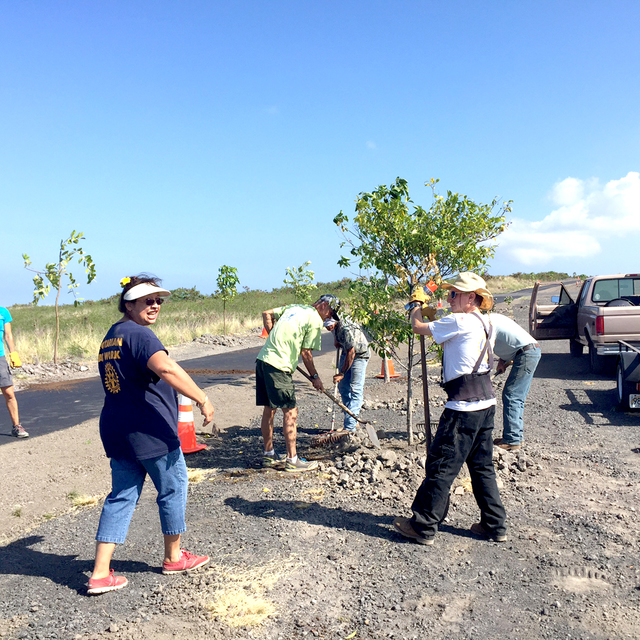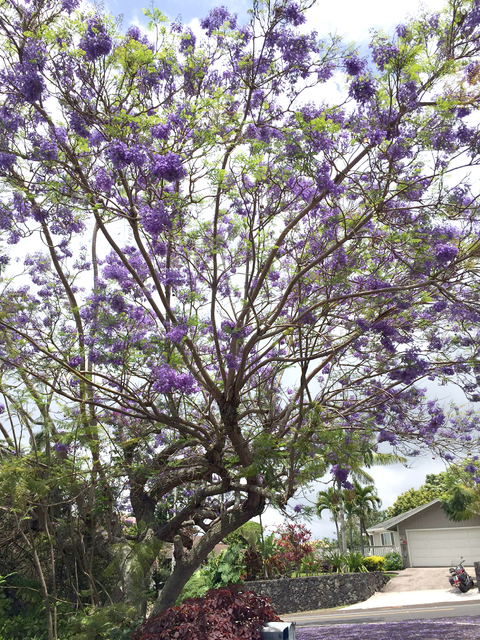Today is May Day — and Lei Day in Hawaii.
We celebrate flowers of all kinds. Traditionally, everyone should be wearing flowers. Fragrant plumeria, pikake, tuberose and orchid leis are appropriate gifts today and for that matter all week through Mother’s Day, May 8. Gals and even guys can wear flowers in their hair at this time.
Of course in islands to the south such as Tahiti, Samoa and Tonga, you will see islanders adorned with flowers all year long. Tropical Polynesia is well-known for using flowers instead of expensive jewels for self-adornment. That is why folks fill their gardens with flowering shrubs and trees, so they will have an abundant supply all year long.
There was a time when forests covered much of the lands that are now grassland and desert in Hawaii. However, with the introduction of grazing animals in the late 18th century, our forests began to shrink. The vast koa forests of the Kohala Mountains, Mauka Kona and East Hawaii are now mere remnants of their past glory.
Loss of forests affects the climate, making hot even hotter, dry drier and windy areas windier. Even places such as Hilo experience extremes of flood and drought when forests in the area are removed.
Lucky for us, some folks know the value of forests and windbreaks. Our progressive ranchers are planting koa and other hardwoods at higher elevations.
Then, there are groups such as the Outdoor Circles, 4-H, Scouts and Rotary, Path and Lions clubs doing what they can to reforest our roadsides and communities. Of course, native plants are important such as hibiscus species, wiliwili, ohia, and greenery including maile and palapalai fern.
However many of the more spectacular flowers have been introduced in the last 200 years. These include royal poinciana, jacaranda, the cassias or shower trees, many species of tabebuia, and fragrant trees such as the ylang ylang and plumeria. The list is so long it covers more than a hundred species.
Well-planned areas such as Kukio, Hualalai, Mauna Lani, Waiakoloa, and Mauna Kea resorts are literally being transformed into tropical oases.
A new project to create safe walking and bike paths is now underway in North Kona. Hundreds of trees are planned for all along Ane Keohokalole Highway. Recently, more than 100 trees were planted through the efforts of Hawaii County, PATH, HELCO, Kaiser, Ironman and the Rotary clubs of West Hawaii.
Another street showing signs of urban beautification is Kaiminani in Kona Palisades now that the road construction is finished. Residents are doing a great job of landscaping their road frontage and the overall effect is impressive. Kudos to all.
These are examples of how individuals can help beautify and make our environment more enjoyable. Folks also can get involved in the state Department of Land and Natural Resources’ Divison of Forestry and Wildlife’s Forest Stewardship Program and agriculture/forest dedication programs through Hawaiian Islands Land Trust and Hawaii County. The latter gives local landowners certain tax savings and benefits our island residents by protecting these lands from urban development.
So, we see even the smallest efforts add up. By planting trees in your garden, you can actually change the microclimate and make your surroundings several degrees cooler in the summer. If you place your trees just right, you can even create a garden climate that is milder during cool, windy periods.
It’s really interesting when you expand these basic principles. What happens when everyone in your neighborhood or community plants shade trees? Well, you can actually change the climate in fairly large areas. Foresters have research data that supports the theory that reforestation might increase local rainfall and modify temperature extremes. By the way, urban reforestation is what is happening when lots of folks in a neighborhood or town plant trees.
Let’s look at the tree planting from another angle.
Visitors bring millions of dollars to Hawaii each year. Our sunny winter skies are a big attraction. It used to be our beaches and tropical woodlands were part of that appeal. Now, with urban sprawl on some of our best beaches, our main salvation from endless asphalt alleys is abundant landscaping.
Planting trees to give shade and beautify our communities isn’t the complete answer, but it can help. Shopping is miserable when streets are barren and parking lots are hot and uncomfortable. Hotels, restaurants and gas stations that are attractively landscaped with shade trees, shrubs and grass attract customers. Even grocery and department stores are finding landscaping pays off.
In tree-planting activities, remember, proper planting is important, as well as a knowledge of the tree’s requirements. Maintenance is the limiting factor as to whether or not street planting is practical. Be sure to choose trees that fit the space where they will grow.
Of course, we need to improve even our best examples of landscaping as we become more sensitive to the regreening of our island.
In some new community developments, underground utilities are installed. This allows freedom from wires and poles. In such well-planned tracts, street side shade trees can be planted to minimize the negative impact of asphalt and concrete. Where utility lines are overhead, it is important to plant trees that stay small, no more than 15 to 20 feet in most cases. This will minimize the problem of maintaining utility services.
In Hawaii, we have a wide variety of native and non-native plants. Therefore, we have a wide variety for beauty and food sources for humans and wildlife. By keeping abundant vegetation as an integral part of our communities, we actually find a constant connection with our natural world.
This information is supplied by the University of Hawaii College of Tropical Agriculture and Human Resources. For further information about gardening and landscaping, contact one of our master gardeners at 322-4892 in Kona or 981-5199 in Hilo.








